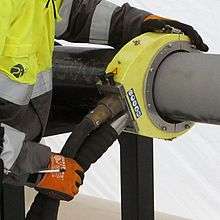Vacuum blasting
Vacuum blasting is an abrasive blasting method,[1] also referred to as dustless blasting or closed loop abrasive blasting.[2] The method is characterized by a blast tool that does abrasive blasting and collects both used blast media, and loosened particles from the surface to be treated, simultaneously.[3] The blast tool is equipped with a blast hose and a suction hose, that both run from the blast tool to a control unit. The control unit supplies the blast tool with pressurized air mixed with blast media, and sucks back dust, loosened particles and used blast media. The control unit continuously separates dust and loosened particles from the used blast media, and sends used blast media back into the pressurized air flow.[3] The dust and loosened particles are collected in a waste bin.[1]

Applications
The method is typically used in areas where dust and spill from regular abrasive blasting is not wanted, for example due to HSE-considerations.[4][5] The blast process itself is slower than regular abrasive blasting, but requires less sheeting and scaffolding [6]
References
- Methods for Removal of Lead Paint From Steel Structures. DIANE Publishing. ISBN 9781428914902.
- Bartolo, Helena; Bartolo, Paulo Jorge Da Silva; Alves, Nuno Manuel Fernandes; Mateus, Artur Jorge; Almeida, Henrique Amorim; Lemos, Ana Cristina Soares; Craveiro, Flávio; Ramos, Carina; Reis, Igor (2013-06-06). Green Design, Materials and Manufacturing Processes. CRC Press. ISBN 9781315879482.
- Three Mile Island, Radioactive Waste Disposal Resulting from Mar.1979 Accident, Unit 2: Environmental Impact Statement. 1981-01-01.
- Khanna, A. S. (2008-07-09). High-Performance Organic Coatings. Elsevier. ISBN 9781845694739.
- Army, United States Dept of the (1990-01-01). Painting of watercraft. Headquarters, Dept. of the Army.
- Winnik, S. (2015-11-26). Corrosion Under Insulation (CUI) Guidelines: Revised. Woodhead Publishing. ISBN 9780081007396.